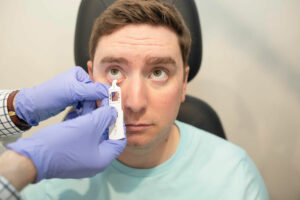
Andrew Lindell, OD, conducts in-office testing with InflammaDry in the office of Stoughton Eye Care & Eyewear in Stoughton, Wis. Dr. Davis says it’s essential to get the coding right for in-office lab tests.
The right way to code for in-office testing that can assist you in making diagnoses.
By Mark K. Davis, OD
March 20, 2024
As optometry moves increasingly into the medical model, we are becoming the first stop for many patients suffering from a “red eye.” Of course, we as doctors, have to make the correct diagnosis to prescribe the proper treatment to alleviate the patient’s discomfort and correct the problem.
To that end, many optometrists have incorporated in their practice “in-office lab tests” to facilitate the proper diagnosis. These are often called point-of-care (POC) diagnostic tests. Physicians have been using them for years in their offices. I will discuss some of the most common ones on the market.
All POC diagnostic lab tests are regulated by the FDA. The Clinical Laboratory Improvement Amendment (CLIA) is the federal regulatory body which sets training and operating standards for POC testing. CLIA also issues certificates for all clinical laboratory testing that use human specimens for the purpose of providing information used to evaluate, diagnose or treat. The FDA categorizes POC tests based on their potential to harm public safety.
Levels of POC Testing Risk
The levels of risk from low to high are:
Waived tests
Tests of moderate complexity
Tests of high complexity
The tests noted in this article all fall within the first category of waived tests.
Billing Lab Tests to Medicare
The Centers for Medicare & Medicaid Services (CMS) is responsible for financial management operations of the CLIA program. Therefore, you can bill the lab tests to Medicare. They may also be paid by other commercial medical plans.
Before jumping into POC testing, you must first apply to become a CLIA certified laboratory. This is done at the CMS.gov website. The step-by-step process is outlined HERE.
You will receive a 10 digit alpha-numeric number that is your CLIA laboratory number. You must also designate a doctor in the practice as the laboratory supervisor. The new optometric associate would be the obvious choice.
Other Articles to Explore
Coding for Most Common POC Tests
Now, let’s look at a few of the more common POC tests and how to code for and bill them. Since the tests are all “waived” tests, they will need the QW modifier. Additionally, the tests are all unilateral, so we will also use the RT and LT modifiers.
Here are three of the most common in-office lab tests, their CPT code and the current reimbursement found in the National Laboratory Fee Schedule at CMS.gov:
83516 – Immunoassay for analyte other than infectious agent antibody or infectious agent antigen; qualitative or semiquantitative, multiple-step method (InflammaDry – Quidel); $11.53 per eye
83861– Microfluidic analysis utilizing an integrated collection and analysis device; tear osmolarity. (TearLab); $22.48 per eye
87809 – Infectious agent antigen detection by immunoassay with direct optical observation. (AdenoPlus – Quidel); $21.76 per eye
An example of coding for the POC test would be:
87809 – QW – RT
87809 – QW — LT
One last note, when entering the claim on a CMS 1500 form, in box 20 indicate that you did NOT use an outside lab. Also in box 23, enter your CLIA laboratory number.
These POC tests are not necessarily a “cash cow” for an optometric practice, but they do provide a valuable service to your patients. In addition, if you are borderline on the diagnosis of a “red eye,” these tests may be just what is needed for that definitive diagnosis.
Until next time…Happy Coding
 Mark K. Davis, OD, is a Therapeutic Optometrist and Optometric Glaucoma Specialist, Diplomate, American Board of Optometry, Adjunct Assistant Professor, University of Houston College of Optometry and Chief of Optometry, 147th Medical Group. He is Lt Col, Texas Air National Guard, Ellington Field JRB, Houston, Texas. To contact him: mkdavisod@gmail.com
Mark K. Davis, OD, is a Therapeutic Optometrist and Optometric Glaucoma Specialist, Diplomate, American Board of Optometry, Adjunct Assistant Professor, University of Houston College of Optometry and Chief of Optometry, 147th Medical Group. He is Lt Col, Texas Air National Guard, Ellington Field JRB, Houston, Texas. To contact him: mkdavisod@gmail.com

























